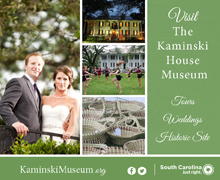
Halcyon Days
Persevering through the best and worst of times, there are only happy days ahead for Edgefield’s grand house on the hill.
The Town of Edgefield teems with history. It is embedded in the clay that forms its unique and famous pottery, and adds flavor to its soft, sweet peaches. It regales us with sensational stories of murder and mayhem, yet can claim ten South Carolina governors as native sons. For almost two hundred years, from its perch atop the ridge that runs along Buncombe Street, the house called Halcyon Grove has not only watched Edgefield’s history being made, it has played its own role in both town and state destinies.
From behind its unique lattice-columned porch, Halcyon Grove has listened to the laughter of generations of children at play and the soft voices of ladies serving afternoon tea. Its walls hold the thoughts and dreams of a man whose aspirations led him to South Carolina’s highest office, and a man who had already worn the mantle of Governor and borne its responsibilities. The property’s history sometimes circles back upon itself, and while it has known the peace and tranquility implied by its name, it has also known the deep valleys that run between prosperity and poverty, feast and famine, celebrations of new life and long, sad journeys into the good night.
While its auspicious past could have made it a candidate for reincarnation into a staged, museum-style package, when Tim and Beth Worth purchased the house and all its furnishings ten years ago, they felt the house speak to them in a different way.
“There was all this furniture, and all these books and photographs and documents dating back to the 1700s that had just been stuffed into drawers. The man we bought it from was in his seventies, and had three other houses. When he left, I don’t think he took anything with him but his toothbrush,” says Beth. “I guess it’s lucky that a person obsessed with history bought this place. Anybody else would have probably thrown a lot of stuff out.”
The home was a goldmine of information about the connections between former owners. Simply keeping up with first, second, and third marriages, deaths (particularly of wives), children, and stepchildren must have required a spreadsheet, a tumbler of Maker’s Mark and a couple of aspirin. But with help from several historians, the couple pieced together the story and got to know the players – some who have apparently never moved on to their heavenly homes.
“Tim used to say I was crazy, but not anymore,” says Beth. “There are three different apparitions that people ‘see’ here – without any prompting from us. It’s usually when there is a lot of commotion in the house. That makes me even more interested in the history. They aren’t scary or spooky, and I want to know who these people are that I’m walking around with every day.”
While Beth can impressively recite the provenance of the property practically from memory, following the chain of ownership is complicated to say the least, and one might safely assume that eventually everyone was related to everyone else. An attempt to connect the dots of the first fifty years looks something like this:
The land on which Halcyon Grove sits was first granted to William Simkins, son of Arthur Simkins, “the Father of Edgefield,” in 1784. When he died, he willed ownership to his father, who in 1811 bequeathed it to another of his sons, Eldred Simkins – the “earliest and best friend” of famous Carolinian, John C. Calhoun.
In 1824, new owner and Clerk of Court, Daniel Bird (who had tragically lost his first wife and two daughters), and his second wife, Lucinda, built Halcyon Grove on a two-acre tract of land purchased for $135. With their three children, soon to be four, the Birds moved into the grand house, built with great attention to detail and no expense spared. But, sadly, as would happen all too often over the house’s history, Daniel Bird lost his second wife in 1826. However, he married her sister, Behethland Simkins, in 1827. They had four more (rounding out his number of progeny to ten) and forever merged the Simkins and Bird families.
When Bird sold the property to Francis W. Pickens for $3,000 in 1829, he had no idea it would become home to both former and future South Carolina Governors. Pickens was married to Margaret Eliza Simkins, the eldest daughter of Eldred Simkins, bringing the property’s ties to the original family full circle. When they left, Pickens’ father, former Governor Andrew Pickens (serving 1816-1818) and his second wife moved to Halcyon Grove. While it isn’t clear, records indicate that Andrew Pickens eventually purchased the house from his son, who went on to serve in the SC House of Representatives, marry twice more, become Ambassador to Russia, and be elected Governor of South Carolina.
Over the next century and a half, the house changed hands more than a half dozen times. While it is hard to keep up with the number of occupants, it is safe to say that this cast of characters endured the triumphs and travails of wars, reconstruction, the great depression, and the ravages of time. By the time the Worths purchased the property in 2008, it had largely been unoccupied for several years, watched over by trusted caretakers. Beth had always had an affinity for old homes, and was delighted when Tim expressed his interest in finding and restoring an aging, plantation-style home.
There is an air of contentment under the roof of Halcyon Grove today, and much like that of its owner, the home wears the comfortable elegance of a Southern lady at ease in her own skin. Under the Worths’ stewardship, the grand house has been returned to a home in every sense – where one can easily envision the light of a thousand fires dancing beneath intricately carved mantels, generations of leather boots and delicate slippered feet polishing heart pine floors to the color of honey, and conversations of consequence held in out-of-plumb corners.
Incorporating her own style into the décor, Beth nestles modern touches alongside antiques. She also pays homage to the previous occupants by scattering their art and furnishings throughout, and portraits of Civil War generals stand alongside those of her own family. Tim’s woodworking skills have seamlessly blended custom kitchen cabinets and other updates with those of the original craftsmen. Their selection of light, airy colors brings life to rooms that were once dark and dreary. The result is a delightful balance that would no doubt still feel like home if the Birds or Pickenses were to visit today.
“I found an 1870 inventory of the house in the drawer of one of the secretaries in the living room,” Beth says. “I could not believe the things on that list that I could check off as still being here. I don’t think that anyone realized what was here. There were cannon balls in the attic, and there are trunks that I have yet to open. It has all really helped me to get to know this house. It is a jewel.”
Beth’s recent retirement from the fashion industry, and Tim’s retirement as an engineer has given them a bit more time to ponder the property’s never ending to-do list, and despite the time and expense required, it is obvious that each task is a labor of love. Though they rewired and re-plumbed and added a few modern conveniences, from the start they felt strongly about maintaining the home’s character.
“We really haven’t changed much,” says Beth. “I just never have felt that was the right thing to do.” It is an attitude that is aptly described in a 1941 quote by Archibald Rutledge that hangs on the sleeping porch, and reads ,“I am but a visitor here in this stately home. I am therefore trying to be a considerate guest.”
By definition, the word ‘halcyon’ denotes a period of time in the past that was idyllically happy and peaceful. Thanks to Tim and Beth Worth, for the house called Halcyon Grove, the happy days are most definitely here again.
To find more detailed information about Halcyon Grove and its place in the history of Edgefield County, visit Edgefield County Historical Society at www.historicedgefield.com.
By Susan Frampton
Recommended
-
Halcyon DaysApril 16th, 2018
-
The Harbinger of HospitalityNovember 21st, 2017
-
Refined & RememberedAugust 25th, 2017
-
Fragrance of Remembrance – The Rosemary InnNovember 1st, 2016
-
Luck of the DrawOctober 12th, 2015


















